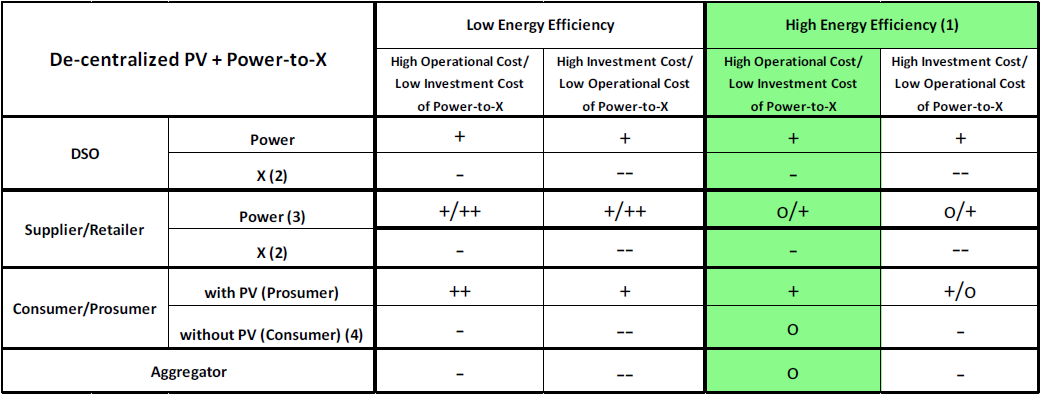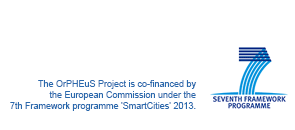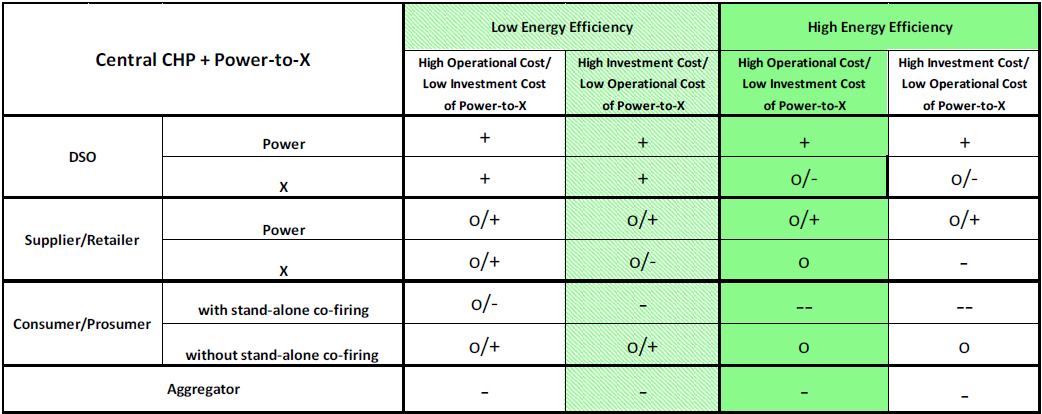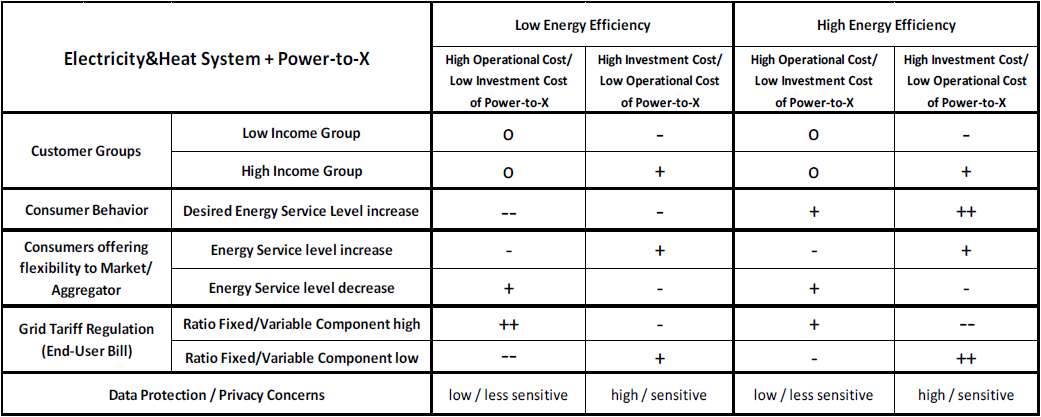Recommendations
Based on the results achieved during the OrPHEuS project, this section presents recommendations for energy actors wishing to implement hybrid energy grids in other related contexts.
- Technical replication and transferability potential on wider European scale
- Recommendations for Cooperative Control Strategies for cities’ Hybrid Energy Networks across Demo sites and on European scale
- Recommendations for the underlying M2M ICT system
- Recommendations for the meteorological information
- Sustainable business development and application area for business models and its impact on Policies Making
- Economic relationships
- Social/socio-economic and regulatory relationships
- References
Technical replication and transferability potential on wider European scale
Recommendations for Cooperative Control Strategies for cities’ Hybrid Energy Networks across Demo sites and on European scale
The OrPHEuS project has studied five main energy hybridization scenarios for two target sites, each with a range of variations in terms of energy demand, supply, prices, and device configurations. Control strategies have been designed in a way that each control strategy would be applicable to all variations of one particular scenario. In the following paragraphs we summarize the experiences from control strategy design and evaluation in the form of recommendations.
When designing control strategies for a particular scenario, a number of aspects of the scenario have to be taken into account. The first question is:
What are the controllable coupling points?
In [1] we have given a categorization of coupling points (CP). First-order CPs directly transfer energy from one grid to another. Second-order CPs are devices which indirectly transfer energy by being able to supply energy to multiple grids, or by being able to satisfy their energy demand from multiple grids. Finally, third-order coupling points are energy producers or consumers that are connected to only one grid but still offer some amount of controllability, and so operating them in combination with a first- or second-order CP can still influence other grids. Coupling points of each of these categories should be considered to be included into the control approach for a given scenario. As shown in [1], we have experimented with coupling points of all categories in the OrPHEuS project.
Having identified the coupling points, the next question is:
What level of control do the coupling points offer?
Some coupling points only admit on/off control, while others expose one or more continuous control variables that enables the controller to realize fine-grained control over how much energy is transferred between the grids, or how much energy from which grid is produced or consumed. Coupling points often also have some dynamicity constraints, restricting the velocity of changing the input and output. Typically – and this was also the case in the OrPHEuS scenarios – large-scale devices offer more fine-grained control than smaller devices. In situations like the Ulm present-day scenarios, where the coupling points were small-scale devices on the consumer side, the required fine grained control was not on these individual devices. However, due to the large numbers of such devices the control strategies were able to carefully switch on or off some smaller or larger subset of coupling points, thus still having fine-grained control with regard to the aggregated behavior and the overall effects on the electricity grid.
The next question regarding the coupling points is:
What are stateful parts of the setup?
Stateful system parts are those where control actions conducted at some time have an effect not only on the immediate future state, but on a whole time horizon in the future. Stateful system parts need the control strategy to plan ahead; possibly not only acting to optimize the current state, but also to consider the future. In the OrPHEuS scenarios stateful system parts were storages and large coupling points with limited dynamicity like e.g. a biomass boiler having a long ramp-up time.
Another relevant question is related to the quantities of coupling points:
How large and complex is the hybrid setup?
The scale and complexity of the system has an impact on the applicable control strategies. For example, centralized controller modules can become a bottleneck or even a single-point-of-failure in very large systems. In the OrPHEuS project the scale of the systems addressed has not been prohibitively large, but [1] contains an analysis and recommendations regarding the scalability of the applied control approaches.
The final question to analyze is:
What are the control targets?
The main selling point for hybridization is that multiple grids will experience a benefit from the interconnection. This already hints at the fact that typically there is more than a single control target. In some cases – especially when a single stakeholder owns the entire infrastructure – a single target like cost minimization or CO2 reduction can be applied. The other extreme are cases where hybridization takes place at the consumer side, and then each individual consumer needs to have a benefit of some sort. In OrPHEuS we had both extremes occurring in our scenarios. In the technical simulations we have in many cases simply assumed a cooperative behavior of the coupling points, leaving the design of suitable incentive models to business development and analysis. However, we have also experimented with control strategies with self-optimizing coupling points (see below for a discussion), and each of the control strategies had several KPIs that were taken into account in the design phase and which were evaluated in the experiments.
Having analyzed the scenario at hand according to the above questions, the designer of the control strategies is able to take decisions regarding a number of control aspects. In [1] these aspects have been identified as controller architecture, cooperativeness, and data usage.
Cooperativeness of control strategies have been proposed by the OrPHEuS project from the very beginning. Indeed, our hybridization setups with consumer-side coupling points have shown that the cooperative strategies Control-2 and Control-3 had a clear advantage over the strategy Control-1, where the individual households targeted at consuming only their own energy surplus from PV production.
The controller architecture aspect relates to the individual control modules and their interconnection. On one extreme end of the spectrum there is centralized control where a single control module receives all relevant real-time and predictive data, takes decisions for each of the coupling points, and communicates these control decisions to the coupling points which only execute them. This approach has the advantage of a global view and the (theoretical) possibility to take globally optimal decisions, but this comes at the price of a lacking scalability and the risk of a single point of failure. On the other extreme, completely decentralized controllers define an own control module for each individual coupling point, which might receive data from nearby sensors and other coupling points, but takes any decision autonomously. This kind of architecture is more robust and scalable, but control decisions tend to be suboptimal, e.g. overreacting to situations. In most practical situations with a large-scale system a hybrid setup is recommendable, where important strategic decisions are centralized, but the execution is left to local controllers. An example of such a strategy is Control-2 in the first Ulm present-day scenario presented in [2], whereas Control-1 and Control-3 in that scenario is a completely decentralized and a completely centralized controller, respectively. In the OrPHEuS, due to the simulation environments and the limited scale of the scenarios, the disadvantages of centralized controllers were not directly visible; thus there is a tendency towards centralized controllers in most scenarios.
In the controller design there is a degree of influence on the input data that is used. Thanks to the latest Internet-of-Things technology and Big Data analytics, there is an abundance of possible data sources to be taken into account by the controllers. Although the current trend is to use as much data as possible, not all data is equally relevant, and from our discussions with stakeholders we learnt that the deployment of sensing infrastructure is far from being trivial and cheap. This might change in the future with the further advance of machine-to-machine communication, but still the lesson learnt is that a conservative approach first trying to achieve good control results with as little dependence on real-time data as possible is recommendable.
A question regarding the internal algorithms of the controllers is that of greediness vs. conservativeness. Greedy algorithms try to maximize the benefit in each time step with no or only little regard of the future. While this approach sounds naïve, it often turns out a valuable solution in practice because of its robustness. Greedy strategies are not dependent on models of how the system will look like in the future; they only react to the current system state at any moment. Therefore they are robust against model changes and model inaccuracies, and this is also confirmed in our experiments. On the other hand, some degree of taking the future into account still has to be applied when there are devices involved where the dependency of present and future is over a long period of time, which is true e.g. for seasonal storages. In some of the OrPHEuS scenarios we have applied rule-based policies to prepare e.g. for demand peaks in the near future.
Recommendations for the underlying M2M ICT system
Considering the impact from the underlying ICT platforms the following conclusions (as mentioned above already) can be summarized:
- The “horizontalization” and auto-configuration mechanisms as described for the OrPHEuS M2M platform are a crucial aspect for making use of data from other IoT monitoring systems and by re-using existing ICT systems (i.e., in other Smart Grid ICT infrastructures, but also ICT infrastructures of related Smart City domains).
- The OrPHEuS reconstructability-based data filtering architecture and algorithms (presented mainly in [3]) will greatly help to reduce ICT costs and network loads of future IoT systems and their linking platforms.
- OrPHEuS data filtering logic and ICT recommendations (mainly [3] and [4]) will be helpful to ensure the Quality-of-Information of energy-related data when it is collected, managed, and filtered by M2M platforms that serve the energy as well as other Smart City domains.
Recommendations for the meteorological information
As mentioned above already, we observed however also, that there is a need for training for the experts working at the interface of both meteorological and energy system ‘worlds’. By intention the work in this project used the ECMWF weather forecast widely as it is available on the global scale. It has however also be found that accuracy of forecasts would be subject of the region of interest and are generally not transferrable between regions.
With respect to the impact on control strategies as applied in the OrPHEuS project, a somewhat surprising outcome of the project has been that greedy strategies (i.e. strategies that do not take into account past data or future predictions) are almost always performing better or nearly-as-good as prediction-informed strategies ([5], chapter 3). In regard to this learnt fact, meteorological information does not seem as critical as previously envisaged to hybrid grids control strategies, as long as sensory data is readily available in real time.
We did still simulate non-greedy control strategies, notably at the Skellefteå site where we decide whether to switch the biomass boiler depending on the predicted presence of a consumption peak during the day. Such a use-case does not need to use extremely accurate fine-grained meteorological information. Adding a large amount of noise to the data did not seem to heavily degrade the performance of the control strategy either.
Additionally we found out that inaccuracies and simplifications of the control strategy’s internal models (heat storage, CHP, etc.) are responsible for a much larger performance impact than prediction inaccuracies. We therefore concentrated mostly on refining these models and tuning the control strategies, rather than analyzing effects of missing/erroneous meteorological data.
Sustainable business development and application area for business models and its impact on Policies Making
The major objective of this section is to decouple from the demo-site specific framework in the OrPHEuS project in terms of business model development and to derive an overall synthesis of the project outcomes to enable sustainable business model design and future applications in a wider European scale. This includes also recommendations for replication and transferability of the demo-site specific framework for general policy making in hybrid energy systems. Here it is also important to note, that sustainable business model development also expects transparent and robust legislation/regulations as well as non-discriminatory treatment of several market participants involved along the entire energy supply chain in a hybrid energy system. Therefore, this task is a highly interdisciplinary one, considering also socio-economic and behavioral aspects of consumers/prosumers.
First and foremost, it is important to note that any energy sector-coupling – finally resulting in a more advanced hybrid energy infrastructure (compared to the status quo) – is built upon an existing energy infrastructure. And this existing energy infrastructure usually is characterized by sunk cost; meaning that at least parts of this existing energy infrastructure also build the backbone for an advanced hybrid energy infrastructure in the future with more coupling points across the different energy domains. Against this background, the two different demo-sites in the OrPHEuS project build an excellent foundation to derive recommendations on sustainable business model design in a more electricity-dominated initial energy infrastructure (Ulm), on the one hand, and a more heat-dominated system (Skellefteå), on the other hand. A further important aspect for sustainable business model development is – regardless of the anatomy of the existing energy system – the ambition in terms of future energy efficiency implementation, because energy efficiency standards finally determine the absolute level of energy demand having to be covered. And varying energy demand, ultimately, is a very sensitive parameter resulting in uneven distribution of individual economic positions across the different market participants involved in energy service provision and thus oppose in many cases the ultimate goal of the implementation of cooperative strategies across several players involved.
The first set of recommendations below addresses the direct economic relationship between the different market participants involved in energy service provision along a hybrid energy supply chain. This means that recommendations for sustainable revenue streams of several market participants involved (i.e. supplier/retailers, distribution grid operators, consumers/prosumers, aggregators) are derived, building upon robustness tests of varying economic parameters (like investment/operational cost relationship of new coupling technologies, changes of relationship of different grid tariff components, etc.).
The second set of recommendations below addresses social/socio-economic and regulatory relationships in sustainable business model development. This includes – among others – varying needs and behavioral aspects of different groups of customers/prosumers (e.g. those with versus without PV self-generation), non-technical and regulatory barriers having to be overcome to enable implementation of sustainable business models.
Here it is also important to note, that the general recommendations derived in this section are not only the synthesis of the direct OrPHEuS project outcomes, but also incorporates the essence of the several OrPHEuS stakeholder and dissemination events.
Economic relationships
In the following Table 1 & Table 2 a synthesis of the direct economic relationship of the business models derived in the Orpheus project is presented in qualitative terms. This means, that these relationships finally can be used for sustainable business model development in hybrid energy systems in general. Whereas Table 1 focuses on a predominantly electricity-based initial energy infrastructure (i.e. synthesis of recommendations of the Ulm demo-site), Table 2 focuses on a predominantly heat-based initial energy infrastructure (reference in the synthesis to the Skellefteå demo-site).
Both Table 1 and Table 2 are split into separate columns for high versus low energy efficiency, on the one hand, and combinations of high versus low operational/investment cost (and vice versa) of new coupling technologies to be implemented into an initial energy infrastructure, on the other hand:
- Although future business model design shall automatically expect the implementation of high energy efficiency standards (and thus lower specific energy demand compared to the status quo), this can’t be guaranteed. Therefore, both cases in terms of future energy efficiency ambitions are considered in future business model design.
- In addition, several possible hybrid coupling technologies are described by couples of high versus low operational/investment cost (and vice versa). This generalization enables decoupling from the specific hybrid energy technology portfolios analyzed in the Orpheus project and guarantees the recommendations of general business models in hybrid energy systems.
The interpretation of Table 1 (electricity-dominated initial energy system) is as follows: it describes – in qualitative terms compared to the status quo – the development of the revenue streams / cost positions of each market participant (existing as well as potential new entrants) when assuming already a certain share of decentralized PV penetration in the system as well as further integration of hybrid coupling technologies (“Power-to-X”) into the system. The following overall effects can be observed:
- Market entry of new market participants, as there are e.g. distribution grid operators for heat and/or gas as well as suppliers/retailers for heat and/or gas is virtually impossible. There are no market shares as well as no sustainable business models visible for these potential new entrants. Aggregators only might be rewarded – in a high energy efficiency case and low investment cost for Power-to-X technologies – with entry and sustainable revenue streams in this particular case.
- The aggregator in this special case could enter and sustain in the market if corresponding pooling of PV feed-in to the electricity grid and/or aggregation of Power-to-X services is more profitable on aggregated than individual level (higher transaction cost and no economies of scale). In addition, the aggregator can offer invoicing/billing services for several of the remaining market participants. This is most probable in a hybrid energy system characterized by high energy efficiency implementation.
- The economic framework is most sensitive for customers without PV self-generation. This means that a Pareto-optimum – an economic setting where none of the market participants loses (compared to the status quo) if several others win – is difficult to reach. This is mainly due to the fact that in electricity-dominated systems with further prosumer-motivated PV self-generation several residential energy services (also heating, cooling, and hot water) are increasingly covered by electricity. This can lead to the effect, that consumers without PV self-generation increasingly cross-subsidies this development e.g. in case the variable component of the grid tariff (or the relationship between the fixed and variable component of the grid tariff) remains unchanged. Moreover, this effect is even worse for the customer without PV self-generation in case of low energy efficiency implementation and thus higher electricity demand (see also corresponding row in Table 1). A more dominant fixed grid tariff component (on the expense of the variable component) can relief this relative disadvantage for the customer without PV-self generation. In case of high energy efficiency implementation the economic situation of this customer group can be locked-in in the initial situation again. Therefore, this is the most promising situation for a cooperative strategy among several market participants and customer groups and thus the implementation of sustainable business models.
Concluding, a Pareto-optimal cooperative strategy among existing market participants (and a potential new aggregator as an entrant) is possible only in a high energy efficiency scenario and low investment cost of a Power-to-X coupling technology.
Table 1: Sustainability of Revenue-Streams / Cost Position per Market Participant in an electricity-dominated hybrid energy system

Footnotes for Table 1:
(1) Having in mind the targets of the European Energy Efficiency Directive and the fact that the CO2 abatement cost of energy efficiency are negative, the adaption of consumers/prosumers to high energy efficiency standards in the future is supposed to be rational. However, decision making of consumers/prosumers on large-scale is not necessarily purely rational in practice.
(2) X describes energy domains heating/cooling and gas. Market entry for distribution grid operators and suppliers/retails for heating/cooling and gas is virtually impossible in electricity-dominated energy systems.
(3) Supplier/retails benefit from increasing sales of electricity covering also remaining residential energy services as there are heating, cooling, hot water, etc.
(4) Whereas consumers with PV systems for self-generation (and feed-in of excess generation) are called prosumers, those without PV systems are still called consumers.
Similar to the interpretation of Table 1, Table 2 is discussed in terms of sustainable business model development in heat-dominated initial energy systems with additional Power-to-X technology implementation. Again, the development of the revenue streams / cost positions of each market participant (existing as well as potential new entrants) is presented in qualitative terms (compared to the status quo). The following overall effects can be observed:
- Market entry for new players like aggregators is virtually impossible. There is no convincing business case recommending this (see Table 2).
- Although a high energy efficiency scenario for the future is preferable, also in a low energy efficiency scenario there exists a similar case representing a sustainable economic framework (notably the case with high investment cost and low operational cost of additional Power-to-X technologies). Therefore, both scenarios enable the implementation of cooperative strategies among several players involved and thus sustainable business model design. In the high efficiency scenario hosted by an initially heat-dominated system low investment cost of additional Power-to-X technologies are recommended to maintain corresponding revenue streams and cost positions of the different market participants involved. There is only one small negative aspect for customers preferring stand-alone co-firing in addition to grid-connected heating supply: this option is expected to be highly uneconomic. However, overall also in heat-dominated systems the high energy efficiency case combined with low investment cost of Power-to-X technologies is qualified for sustainable business model implementation across several market participants and customer groups.
Table 2 Sustainability of Revenue-Streams / Cost Position per Market Participant in a heat-dominated hybrid energy system
Social/socio-economic and regulatory relationships
In an overall synthesis and thus generalization of the outcomes of the Orpheus project in terms of social/socio-economic and regulatory considerations for sustainable business model development in a hybrid energy system environment, the following aspects are supposed to be the most important:
- Consideration of different customer groups, notably the low income versus high income segments.
- Varying consumer behavior in terms of desired energy service levels.
- Flexibility of consumers/prosumers offered to the market/aggregator.
- Grid (end-user) tariff regulation, notably in terms of ratio of fixed versus variable component.
- Consideration of data protection and privacy concerns.
In the following, each of these aspects is discussed more comprehensively, referring also to the qualitative assessment in Table 3:
- Customer groups: Mainly depending on the income, different consumer groups have different degrees of freedom to invest in high energy efficiency as well as Power-to-X technologies characterized by high investment cost. Therefore, low income customers are rather locked-in to the status quo; meaning that they are at least not negatively affected (in economic terms) by any investments of remaining customer groups into novel, sophisticated Power-to-X technologies.
- Consumer behavior: The key indicator measuring consumer behavior is energy service level variation. In general, both directions of energy service level variation are possible. However, in low energy efficiency scenarios increasing energy service levels negatively affects the cost position of customers. Therefore, energy service level (comfort) increase is most beneficial (least costly) in a high energy efficiency scenario accompanied with further novel, sophisticated hybrid energy coupling technologies.
- Flexibility offered: In many cases, customers can offer flexibilities to the electricity and/or heat market (or an aggregator) without negative implications in terms of convenience/comfort. This is possible due to the inertia of some of the customer applications(e.g. heat pump, freezer, refrigerator, grid connected heating and cooling systems, etc.). Typical market segments for the provision of short-term flexibilities taking advantage of inertia of hybrid energy systems are balancing electricity markets. From the economic point-of-view it is a win-win situation for both customer and market agent. Moreover, this could be a key factor for a sustainable business case of an aggregator.
- Grid tariff regulation: Regulatory issues in general, and grid tariff regulation in particular, is one of the most sensitive factors in hybrid energy systems at the presence of high shares of local self-generation and feed-in of local excess generation. This can negatively affect revenue streams of distribution grid operators. In order to mitigate this challenge, usually the ratio of fixed/variable grid component is increased. This guarantees more independent revenue streams for distribution grid operators in distributed hybrid energy systems. However, a higher share of fixed tariff component also negatively affects price elasticity of energy demand; meaning that energy saving and thus energy efficiency implementation is less attractive from the customers’ point-of-view. So there is a feedback loop having to be taken into account in this respect in order not to open another “problem field” (i.e. undermining energy efficiency implementation).
- Data protection/privacy: Finally, also data protection/privacy issues need to be considered, notably in hybrid energy systems with high shares of novel, sophisticated Power-to-X technologies. Because here the time resolution and the amount of individual data of customers is very high and, therefore, need to be treated with care. Aggregator could find a business case also here to aggregate, maintain, and further process data (e.g. for billing and invoicing purposes). Moreover, this could bring additional services to the hybrid energy market where several of the incumbent players benefit.
Table 3 Social/socio-economic and regulatory relationships feeding into sustainable business model development in hybrid energy systems
References:
These OrPHEuS reports are marked as Public (PU) or Restricted (RE). Public reports are available in this section of the website.
- T. Jacobs, S. Nicolas, A. Schülke, „OrPHEuS Deliverable D5.5 (PU): Scalability and applicability of control approach,“ 2017.
- T-.G. Noh, S. Nicolas, D. Schwabeneder, A. Schülke, H. Auer, „OrPHEuS Deliverable D5.3.1 (RE): Evaluation of Control Strategies in the Simulation Environment,“ 2016.
- A. Papageorgiou, C. Åhlund, S. Saguna, „OrPHEuS Deliverable D3.1.2 (RE): Design and evaluation of prototype of connected M2M gateway and data filtering solutions hosted on M2M gateways,“ 2015.
- A. Papageorgiou, C. Åhlund, K. Mitra, S. Saguna, „OrPHEuS Deliverable D3.1.3 (PU): Recommendations for ICT M2M Infrastructure for the evolution towards Cooperative Hybrid Energy Grids integrated in Smart Cities Operation centre,“ 2016.
- T. Jacobs, S. Nicolas, A. Schülke, „OrPHEuS Deliverable D5.3.2 (PU): Recommendations for control strategies on future use cases,“ 2017.




